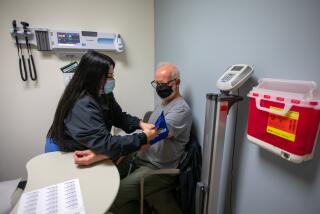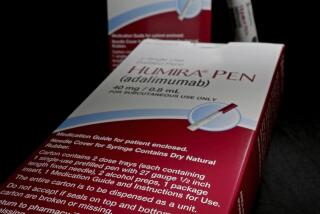Firm Aims to Close in on Pacemaker Sales Leader
- Share via
In mid-August, Siemens-Pacesetter Inc., a Sylmar manufacturer of heart pacemakers, got federal approval to start selling its latest pacemaker, the Synchrony.
The device, which costs doctors $6,300, is the most sophisticated and expensive pacemaker Siemens-Pacesetter has yet designed. Chairman Alfred E. Mann believes that Synchrony will enable his company, the industry’s No. 2 player with about 25% of the $1.2 billion in annual worldwide pacemaker sales, to grab an additional 4% to 5% of the market.
A big jump on the competition? Hardly. Before you could say “cardiovascular system,” Medtronic Inc., the industry leader with about 43% market share, got federal approval to start selling its Synergist II pacemaker, which competes head-on with Synchrony.
Nonetheless, Siemens-Pacesetter’s ability to bring new products to market in tandem with Medtronic reflects its rapid growth over the past decade. Siemens-Pacesetter, a unit of the West German conglomerate Siemens AG, expects to post sales of $250 million for the fiscal year that ended Sept. 30, compared with $10.8 million in 1979, Mann said.
Its surging sales lifted Siemens-Pacesetter from an also-ran to second place in the industry, and its growing stature forces Medtronic--and the half a dozen or so smaller pacemaker companies--to stay on their toes.
“Everybody views Siemens-Pacesetter as the competition,” said Bernard F. McDonagh who follows the industry for the investment firm Piper Jaffray & Hopwood in Minneapolis. “You’ve got Siemens behind them with deep pockets and a long-term commitment.”
Case in point: Siemens, with $30 billion in annual sales, gave Siemens-Pacesetter the go-ahead to build a $30-million, 208,000-square-foot plant about a mile from its headquarters.
Mann said that “our ambition is to catch up with Medtronic,” but he acknowledged that “we have a way to go.” Although Medtronic’s sales, which totaled $742 million in the fiscal year that ended April 30, have slowed from their double-digit growth rate of the mid-1980s, they are still growing.
Moreover, Medtronic, a publicly held company that must report its financial results, earns about 23 1/2 cents per dollar of sales before taxes, an exceptional profit margin that makes it easier to finance research and development of new products. Mann declined to divulge his company’s earnings. But he said Siemens-Pacesetter enjoys about the same margin, which indicates its pretax operating income in fiscal 1989 totaled about $59 million.
Carol D. Winslow, an analyst with the brokerage firm Dain Bosworth Inc. in Minneapolis, where Medtronic is based, said that while Siemens-Pacesetter has taken some business away from Medtronic, it is mostly snaring market share from smaller competitors.
Siemens-Pacesetter is “probably hurting Medtronic, but they are not eating Medtronic’s lunch by any means,” Winslow said.
About 100,000 Americans will get pacemakers this year; another 18,000 of the 500,000 who have them will need replacements.
Pacemakers, which cost doctors between $2,000 and $6,500, help the heart maintain a steady beat by electrically sending pulses to the heart. Normally, a part of the heart called the sinus node conducts the heart’s rhythm, slowing it down or speeding it up to match blood flow--and thus oxygen needs--to a person’s activity. But when the sinus node’s ability to pace the heart fails, a pacemaker is often needed.
Early pacemakers (the first one was implanted in a human in 1958) simply kept the heart at a constant rate of 70 to 75 beats per minute, regardless of whether the patient was running or sleeping. They were “single-chamber” devices, meaning that their pulses were sent only to the lower half of the heart, where the main pumping activity occurs.
About 75% of pacemakers sold today remain single-chamber devices. But the new versions can adapt the pacemaker’s rate to the patient’s activity level. Many do so with sensors that pick up the body’s muscle activity.
The other 25% of pacemakers are “dual-chambered” products, which send pulses to the upper and lower chambers of the heart for patients that need such help. And the Cadillacs of the business are the dual-chambered, activity-responsive pacemakers such as Synchrony and Synergist II. After they are implanted, doctors use a table-top computer to program the pacemakers, thus synchronizing the upper and lower chambers of the heart.
Although filled with electronic wizardry, most pacemakers are smaller than a pocket watch and weigh just a few ounces. They are typically implanted between the breast and the collarbone, and doctors send a thin “lead” from the pacemaker through a vein and to the heart. The operation, which once took hours, can be done in 30 minutes, Mann said.
McDonagh said it is too early to tell whether Seimens-Pacesetter’s Synchrony or Medtronic’s Synergist II is the market leader in the dual-chamber market. But Winslow said the Synchrony is technologically superior.
Synchrony is “easier for the physician to program, it has a few more programming options and it’s a little smaller,” she said. Mann claimed that “our technology substantially surpasses” that of Medtronic. “It’s concluded, even by Medtronic, that Synchrony is a superior product,” he said.
Baloney, Medtronic said. The company’s Synergist II is fully competitive and is even “outselling the Synchrony at the present time,” said spokesman Dick Reid, although he declined to disclose sales figures.
Medtronic has sued Siemens-Pacesetter in federal court in Chicago, alleging that Synchrony and one of Siemens-Pacesetter’s single-chamber devices, called Sensalog, infringe on Medtronic’s patents. Siemens-Pacesetter, which has 731 employees, denies any wrongdoing. The trial is likely to start early next year.
Mann, 63, started the company as Pacesetter Inc. in 1969 with Johns Hopkins University, whose Applied Physics Laboratory was searching for ways to improve the longevity of pacemakers. After more than a decade of development, pacemakers still lasted only about 18 months before they had to be replaced. Today they typically last between five and 20 years, depending on the model and the patient’s needs.
Mann, a Portland, Ore., native, was running two Los Angeles companies that he had founded--Spectrolab and Heliotek, which made power systems for spacecraft--when he started Pacesetter. He had sold the two companies to Textron, with his share of the proceeds totaling $10 million, but continued managing them until turning his full attention to Pacesetter in 1972.
His attention couldn’t prevent the company from a run-in with the law in 1983. Pacesetter, its former president and two other executives--not Mann--were indicted on federal charges of paying kickbacks totaling up to $140,000 to doctors who used Pacesetter’s pacemakers. The company and the executives later pleaded guilty or no contest and were fined between $2,000 and $40,000 each.
Mann said most of the charges related to a program in which Pacesetter gave doctors discounts on Pacesetter pacemakers if they used the devices to replace patients’ pacemakers, even if they were rival brands. Mann said he approved the program, and “we still don’t think it was unethical, but it’s technically a violation of the Medicare statutes.” He said some of his competitors offer similar programs.
The other charges involved some of the Pacesetter executives allegedly paying doctors in advance for clinical evaluations of their products. Mann said he was not involved in those incidents, which “were totally contrary to my directives.”
Brian M. Mann, Mann’s son and Siemens-Pacesetter’s chief operating officer, said the kickback case “had a negative effect, but not a major effect” on the company’s sales growth. But he said it was not the reason that Siemens, which had made several unsuccessful attempts to invade the U.S. pacemaker market, bought its way in by purchasing Pacesetter in 1985.
Alfred Mann declined to disclose the purchase price. But sources said it was between $100 million and $200 million, with just under half going to Mann for his stake.
Despite Siemens’ backing, Mann won’t predict whether his company can surpass Medtronic’s sales before he retires--or even when his retirement might be. But one thing is certain: For now, the company remains more than a heartbeat away from becoming the industry leader.
More to Read
Inside the business of entertainment
The Wide Shot brings you news, analysis and insights on everything from streaming wars to production — and what it all means for the future.
You may occasionally receive promotional content from the Los Angeles Times.











